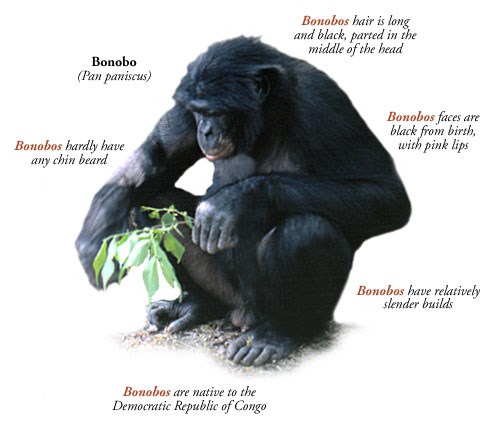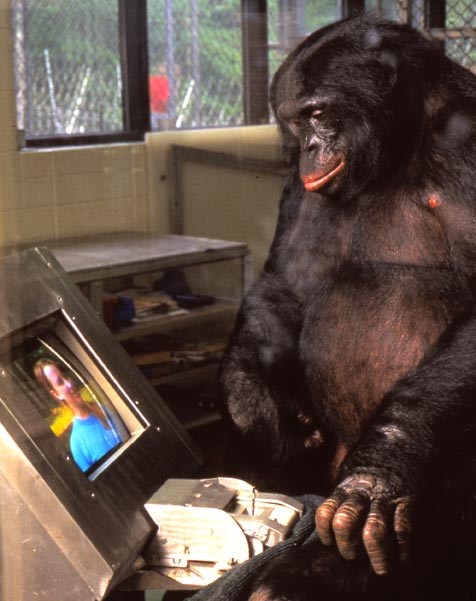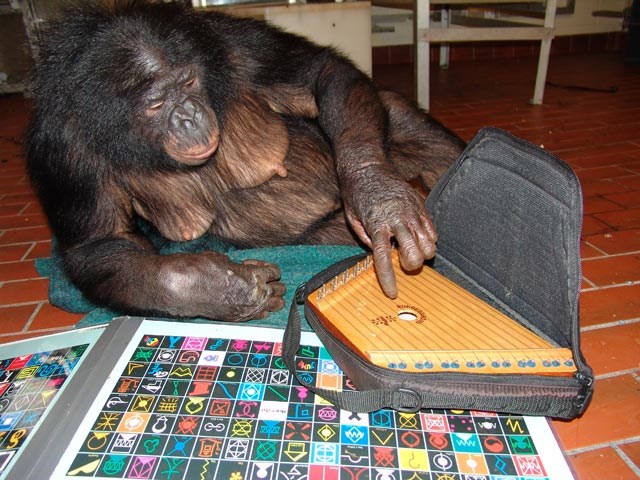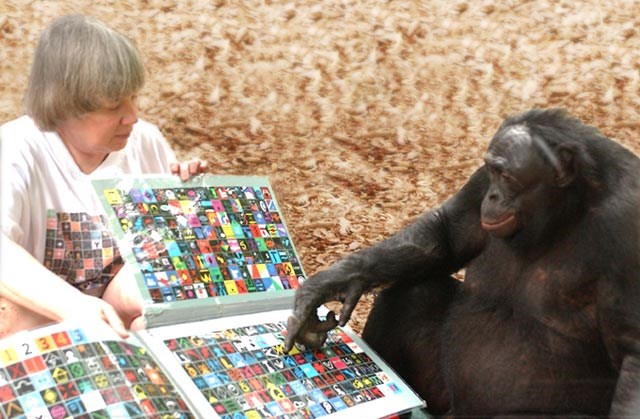 |
| Dr. Sue Savage-Rumbaugh Photo from greatapetrust.org |
Dr. Sue Savage-Rumbaugh converses with apes, specifically, BONOBOS-the Great Apes from the Congo that are the most like humans. Bonobos and people share 98.4% of the same genetic make-up (DNA). And, it seems, they share a few behavioral traits as well. They constantly vocalize "as though they are conversing," and often walk upright. Dr. Savage-Rumbaugh is the lead scientist at GREAT APE TRUST of IOWA, the new world class research center dedicated to studying the behavior and intelligence of great apes. She is in the process of settling in her charges-8 super-intelligent bonobos, recently moved from the Language Research Center at Georgia State University to their new home -- 200 acres of lowlands, river forest and lakes with a 13,000 square foot home where they can cook in their own kitchen, get snacks from vending machines, explore their woods and communicate with researchers from all over the world through computer touchscreens. According to Savage-Rumbaugh, they will be allowed to mate and have families, and develop cultures that will be studied for generations to come. Primate communication is a powerful, new, emerging science. Acquisition of language is only the first step. Dr. Savage-Rumbaugh wants to know how we humans became what we are today. Interested in fire, making rudimentary tools, painting, etc., bonobos clearly have the capacity to learn language, and are thinking, self-aware and intelligent beings. According to Savage-Rumbaugh, LANGUAGE is the home of the mind. Bonobos use lexigrams on a keyboard because their vocal chords don't work the same as humans.
 |
| All about the Bonobo Photo from greatapetrust.org |
Dr. Sue Savage-Rumbaugh received her Ph.D. from the University of Oklahoma in 1975. She is a primatologist, experimental psychologist and one of the world's leading ape language researchers. She works with her husband, the distinguished comparative psychologist, Dr. Duane M. Rumbaugh, a pioneer himself in the study of ape language. While still at Georgia State University, she was asked how their research was shaped by living and working together. "Without our being together, I don't think that one could ever be responsible for as many apes as we have here. Duane and I live right near the research center and we're willing to go there day and night, 365 days a year. If an ape is sick, if one of the apes has gotten free, if Panbanisha is frightened because she's heard the river's about to flood, we go."
There have been lots of disagreements, though. "Duane was very, very upset when I began taking the apes out of their cages. And when I began to say that Lana (Duane's chimp) didn't understand some of the things she was saying and that comprehension of language was important, not just production -- we almost broke up over that. But we really love each other, and we're united in our core beliefs: that there is a huge capacity on the part of apes and probably all kinds of other animals that's being ignored. By ignoring it, humans are separating ourselves from the natural world we've evolved from. The bonobos are a real bridge to that world. At base, no matter how much Duane and I argue, we both know this is true."
 |
| KANZI Photo from greatapetrust.org |
But it all started 25 years ago, and almost by accident. That's when Dr. Savage-Rumbaugh was first introduced to Kanzi, the superstar of the bonobo world. At 6 months of age, the young ape had tagged along to a research session for his adopted mother, Matata. Sue remembers that, "Without warning, Kanzi emitted an electrifying scream and propelled himself from Matata's arms to mine. It was a sign of things to come." For the next 2 years, Sue worked with Matata with a lexigram keyboard producing very disappointing results. During these sessions, Kanzi jumped on Matata's head, stole her reward treats and generally raised havoc. One day, when Matata had to be away for awhile, Kanzi, distraught, searched everywhere for her. Much to everyone's surprise, Kanzi spontaneously started to use the lexigram. He touched raisin and peanut and they gave him those treats. Then he touched melon go and they gave him a melon and took him outside. According to Sue, "Kanzi had been keeping a secret. He had been learning these words all along. We thought he did not know how to talk with the keyboard, but he did."
Kanzi had learned to use the keyboard by observation, not by the reward system. This led Dr. Savage-Rumbaugh to a new way of working. She taught him the same way one does a child, by interesting Kanzi in stuff a bonobo would like to do in the wild, like exploring in the woods for food. So, they set up stations in the dense woods surrounding the research center with his favorite foods. Kanzi was armed with a cardboard copy of his keyboard so he could point out his choices. And the rest, as they say, is history. According to Sue, Kanzi now has a vocabulary of several thousand words and can put them together to form unique sentences describing what he wants. He understands and can communicate back and forth with people. He can make stone tools and is very proud of his ability to flake Oldowan-style cutting knives.
 |
| Panbanisha and musical instrument Photo from greatapetrust.org |
He has also demonstrated his music skills by jamming on his keyboard with the likes of Sir Paul McCartney and Peter Gabriel. "Working with bonobos was an extraordinary experience for me," says Gabriel. It confirmed that there is very little difference between the potential mental and intellectual capacity of the bonobos and ourselves. We forget, most of the time, that humans are Great Apes. I strongly support any measures to save the bonobos from extinction." According to a Des Moines Register reporter that viewed the video of this jam session, "Panbanisha appeared to carefully pick notes one at a time with both index fingers while brother Kanzi seemed more interested in rhythm. Both kept time well."
Dr. Savage-Rumbaugh has had a very distinguished career that is showing no signs of slowing down. With the move to the marvelous new facility in IOWA, her vision of what her family of bonobos can teach us will have very few boundaries. To keep track of her new and exciting findings, visit her Web site often at www.greatapetrust.org. To get involved and find out more, check out the links at the end of this story.
 |
| Kanzi, Dr. Sue and lexigrams Photo from greatapetrust.org |
SOME OF DR. SAVAGE-RUMBAUGH'S HONORS AND AWARDS:
Dr. Savage-Rumbaugh's work with Kanzi, the first ape to learn language in the same manner as children, was detailed in "Language Comprehension in Ape and Child" published in Monographs of the Society for Research in Child Development (1993). It was selected by the "Millennium Project" as one of the top 100 most influential works in cognitive science in the 20th century by the University of Minnesota Center for Cognitive Sciences in 1991. Dr. Savage-Rumbaugh's work is also featured in Apes, Language and the Human Mind (Oxford Press, 1996) and Kanzi: The Ape at the Brink of the Human Mind (John Wiley & Sons, 1995).
Among Dr. Savage-Rumbaugh's other honors during her 25-year career as a researcher and professor of biology and psychology are: The Smithsonian Institution's display of "Understanding Ourselves, Understanding Each Other," sponsored by the American Psychological Association's Centennial Convention; being an invited speaker to the Nobel Conference XXXII (1996); receiving an Honorary Doctor of Science from the University of Chicago (1997); and receiving the Leighton A. Wilkie Award in Anthropology from Indiana University (2000).
Page created on 4/11/2013 9:51:05 PM
Last edited 8/21/2018 8:37:36 PM
Along with chimpanzees, bonobos are genetically our closest living relatives.
Life Span
Bonobos live for up to 40 years.
Statistics
Bonobos are 70-90cm in height. Males weigh 39kg and females weigh 33kg.
Physical Description
The bonobo is very similar in appearance to the chimpanzee, but it has longer, thinner legs, a more slender frame and a narrower face. Its facial skin and hair are black, and it has a prominent white tail tuft.
Distribution
Bonobos live in a small area of land south of the Congo river.Habitat
They inhabit lowland rainforest and swamp forest.
Diet
Bonobos mainly feed on fruit, but also consume shoots, leaves, flowers, seeds, bark, pith, herbs, invertebrates and small invertebrates.
Behavior
They are diurnal, terrestrial and arboreal. Communities number anywhere from 20 to more than 100. They are less aggressive than chimpanzees. Each night, they build a new place to sleep in. They move quadrapedally and bipedally.
Reproduction
Bonobos have a gestation period of 225 days. They give birth to one baby and rarely have twins. The young weigh 1.9kg at birth.
Conservation Status
Bonobos are listed as Endangered. Their habitat is constantly threatened by the fighting being waged in the Congo and by humans hunting them.KANZI
Kanzi means "treasure" in Swahili
Favorite Food: onions
Favorite Toy: red ball
Favorite Game: chase
Favorite Movies: Babe and Iceman
